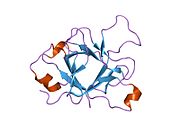Biology:Interleukin 36 receptor antagonist
From HandWiki
Short description: Protein-coding gene in the species Homo sapiens
 Generic protein structure example |
Interleukin 36 receptor antagonist (IL-36RA) is a member of the interleukin-36 family of cytokines. It was previously named Interleukin-1 family member 5 (IL1F5).[1][2][3][4]
The protein is known to inhibit the effects of Interleukin-36 cytokines (IL-36α, IL-36β and IL-36γ) via competing with their receptor IL-36R/IL1RL2 and thereby inhibiting their proinflammatory effects.[5]
Roles in disease
Mutations in the IL-36RN gene resulting in a decrease or production of defective IL-36RA protein have been shown to cause inflammatory skin diseases including generalised pustular psoriasis, acrodermatitis continua suppurativa Hallopeau (ACH) and acute generalized exanthematous pustulosis (AGEP).[6]
References
- ↑ "Four new members expand the interleukin-1 superfamily". J Biol Chem 275 (2): 1169–75. Feb 2000. doi:10.1074/jbc.275.2.1169. PMID 10625660.
- ↑ "IL1HY1: A novel interleukin-1 receptor antagonist gene". Biochem Biophys Res Commun 263 (3): 702–6. Nov 1999. doi:10.1006/bbrc.1999.1440. PMID 10512743.
- ↑ "A new nomenclature for IL-1-family genes". Trends Immunol 22 (10): 536–7. Sep 2001. doi:10.1016/S1471-4906(01)02040-3. PMID 11574262.
- ↑ "Entrez Gene: IL36RN interleukin 36 receptor antagonist". https://www.ncbi.nlm.nih.gov/sites/entrez?Db=gene&Cmd=ShowDetailView&TermToSearch=26525.
- ↑ Towne, JE; Garka, KE; Renshaw, BR; Virca, GD; Sims, JE (2 April 2004). "Interleukin (IL)-1F6, IL-1F8, and IL-1F9 signal through IL-1Rrp2 and IL-1RAcP to activate the pathway leading to NF-kappaB and MAPKs.". The Journal of Biological Chemistry 279 (14): 13677–88. doi:10.1074/jbc.M400117200. PMID 14734551.
- ↑ Navarini, AA; Valeyrie-Allanore, L; Setta-Kaffetzi, N; Barker, JN; Capon, F; Creamer, D; Roujeau, JC; Sekula, P et al. (July 2013). "Rare variations in IL36RN in severe adverse drug reactions manifesting as acute generalized exanthematous pustulosis.". The Journal of Investigative Dermatology 133 (7): 1904–7. doi:10.1038/jid.2013.44. PMID 23358093.
Further reading
- "A physical map of the region encompassing the human interleukin-1 alpha, interleukin-1 beta, and interleukin-1 receptor antagonist genes". Genomics 19 (2): 382–4. 1994. doi:10.1006/geno.1994.1076. PMID 8188271.
- Nothwang HG; Strahm B; Denich D et al. (1997). "Molecular cloning of the interleukin-1 gene cluster: construction of an integrated YAC/PAC contig and a partial transcriptional map in the region of chromosome 2q13". Genomics 41 (3): 370–8. doi:10.1006/geno.1997.4654. PMID 9169134.
- Kumar S; McDonnell PC; Lehr R et al. (2000). "Identification and initial characterization of four novel members of the interleukin-1 family". J. Biol. Chem. 275 (14): 10308–14. doi:10.1074/jbc.275.14.10308. PMID 10744718.
- Busfield SJ; Comrack CA; Yu G et al. (2000). "Identification and gene organization of three novel members of the IL-1 family on human chromosome 2". Genomics 66 (2): 213–6. doi:10.1006/geno.2000.6184. PMID 10860666.
- "Organization of the human interleukin-1 receptor antagonist gene IL1HY1". Immunogenetics 51 (6): 425–8. 2000. doi:10.1007/s002510050640. PMID 10866108.
- Barton JL; Herbst R; Bosisio D et al. (2001). "A tissue specific IL-1 receptor antagonist homolog from the IL-1 cluster lacks IL-1, IL-1ra, IL-18 and IL-18 antagonist activities". Eur. J. Immunol. 30 (11): 3299–308. doi:10.1002/1521-4141(200011)30:11<3299::AID-IMMU3299>3.0.CO;2-S. PMID 11093146.
- Pan G; Risser P; Mao W et al. (2001). "IL-1H, an interleukin 1-related protein that binds IL-18 receptor/IL-1Rrp". Cytokine 13 (1): 1–7. doi:10.1006/cyto.2000.0799. PMID 11145836.
- Lin H; Ho AS; Haley-Vicente D et al. (2001). "Cloning and characterization of IL-1HY2, a novel interleukin-1 family member". J. Biol. Chem. 276 (23): 20597–602. doi:10.1074/jbc.M010095200. PMID 11278614.
- Debets R; Timans JC; Homey B et al. (2001). "Two novel IL-1 family members, IL-1 delta and IL-1 epsilon, function as an antagonist and agonist of NF-kappa B activation through the orphan IL-1 receptor-related protein 2". J. Immunol. 167 (3): 1440–6. doi:10.4049/jimmunol.167.3.1440. PMID 11466363.
- Tazi-Ahnini R; Cox A; McDonagh AJ et al. (2002). "Genetic analysis of the interleukin-1 receptor antagonist and its homologue IL-1L1 in alopecia areata: strong severity association and possible gene interaction". Eur. J. Immunogenet. 29 (1): 25–30. doi:10.1046/j.1365-2370.2002.00271.x. PMID 11841485.
- Nicklin MJ; Barton JL; Nguyen M et al. (2002). "A sequence-based map of the nine genes of the human interleukin-1 cluster". Genomics 79 (5): 718–25. doi:10.1006/geno.2002.6751. PMID 11991722.
- Strausberg RL; Feingold EA; Grouse LH et al. (2003). "Generation and initial analysis of more than 15,000 full-length human and mouse cDNA sequences". Proc. Natl. Acad. Sci. U.S.A. 99 (26): 16899–903. doi:10.1073/pnas.242603899. PMID 12477932. Bibcode: 2002PNAS...9916899M.
- Clark HF; Gurney AL; Abaya E et al. (2003). "The Secreted Protein Discovery Initiative (SPDI), a Large-Scale Effort to Identify Novel Human Secreted and Transmembrane Proteins: A Bioinformatics Assessment". Genome Res. 13 (10): 2265–70. doi:10.1101/gr.1293003. PMID 12975309.
- Zee RY; Fernandez-Ortiz A; Macaya C et al. (2004). "IL-1 cluster genes and occurrence of post-percutaneous transluminal coronary angioplasty restenosis: a prospective, angiography-based evaluation". Atherosclerosis 171 (2): 259–64. doi:10.1016/S0021-9150(03)00294-6. PMID 14644395.
- Ota T; Suzuki Y; Nishikawa T et al. (2004). "Complete sequencing and characterization of 21,243 full-length human cDNAs". Nat. Genet. 36 (1): 40–5. doi:10.1038/ng1285. PMID 14702039.
- Colland F; Jacq X; Trouplin V et al. (2004). "Functional Proteomics Mapping of a Human Signaling Pathway". Genome Res. 14 (7): 1324–32. doi:10.1101/gr.2334104. PMID 15231748.
- Gerhard DS; Wagner L; Feingold EA et al. (2004). "The Status, Quality, and Expansion of the NIH Full-Length cDNA Project: The Mammalian Gene Collection (MGC)". Genome Res. 14 (10B): 2121–7. doi:10.1101/gr.2596504. PMID 15489334.
- Macleod, T; Doble, R; McGonagle, D; Wasson, CW; Alase, A; Stacey, M; Wittmann, M (22 April 2016). "Neutrophil Elastase-mediated proteolysis activates the anti-inflammatory cytokine IL-36 Receptor antagonist". Scientific Reports 6: 24880. doi:10.1038/srep24880. PMID 27101808. Bibcode: 2016NatSR...624880M.
 |


